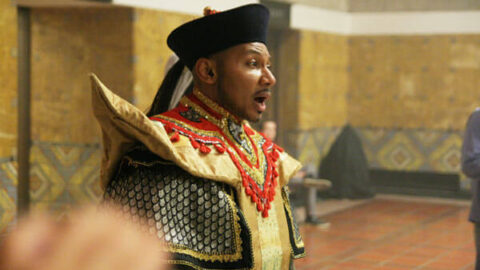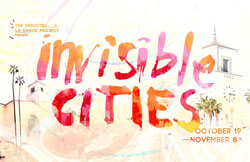 Los Angeles’s Union Station, which will be celebrating its 75th anniversary next year, was the site of the premier of Christopher Cerrone’s new locative opera Invisible Cities, which had an extended run from October 19 through November 10, 2013. Both the brave LA-based opera production company The Industry and its artistic director Yuval Sharon asked their audience to “imagine our future city.” The extraordinary vision of augmented-operatic-reality has drawn people back into this utilitarian, historically-connected feature of Downtown LA in sold-out performances. Simply put, music-drama as it pertains to Invisible Cities became a force of complete urban metamorphosis. Bass baritone Cedric Berry and tenor Ashley Faatoalia, who performed the lead roles as Kublai Kahn and Marco Polo, were joined by a superb cast of singers, instrumentalists, dancers, technicians, and volunteers representing a collaboration between the LA Dance Project, The Industry, and Sennheiser in an ambitious project of remodernizing the idea of operatic inquiry itself. It was a production which left a lasting impression, and one which created a unique performative reality, renegotiating the boundaries between technology and opera, dance and performance, space and place, art and life.
Los Angeles’s Union Station, which will be celebrating its 75th anniversary next year, was the site of the premier of Christopher Cerrone’s new locative opera Invisible Cities, which had an extended run from October 19 through November 10, 2013. Both the brave LA-based opera production company The Industry and its artistic director Yuval Sharon asked their audience to “imagine our future city.” The extraordinary vision of augmented-operatic-reality has drawn people back into this utilitarian, historically-connected feature of Downtown LA in sold-out performances. Simply put, music-drama as it pertains to Invisible Cities became a force of complete urban metamorphosis. Bass baritone Cedric Berry and tenor Ashley Faatoalia, who performed the lead roles as Kublai Kahn and Marco Polo, were joined by a superb cast of singers, instrumentalists, dancers, technicians, and volunteers representing a collaboration between the LA Dance Project, The Industry, and Sennheiser in an ambitious project of remodernizing the idea of operatic inquiry itself. It was a production which left a lasting impression, and one which created a unique performative reality, renegotiating the boundaries between technology and opera, dance and performance, space and place, art and life.

The performance on October 29 began with the audience gathered in the old Harvey House restaurant, arranged in a semicircle around the eleven chamber orchestra musicians, conductor Marc Lowenstein, and audio production mixer Nick Tipp. This was a 10:00 PM performance occurring in what is oftentimes used as a refuge for the more transient, dislocated sector of the downtown demographic; a place where the Don Gatelys and Harry Kemps of the world seek an evening’s respite. Sharon spoke briefly, encouraging the audience’s respectful commitment to their own wanderer-fantasie within the perimeter of the event: the outdoor North and South Patios, the majestic Main Waiting Room, and the imperial Historic Ticket Area. As he wrapped up his opening remarks he reiterated the lack of predetermined trajectory built-in to this performance. No two individual’s observations of Invisible Cities would be alike. Maestro Lowenstein then raised his baton to begin the overture, sending the collective curiosity into a heightened sensitivity.
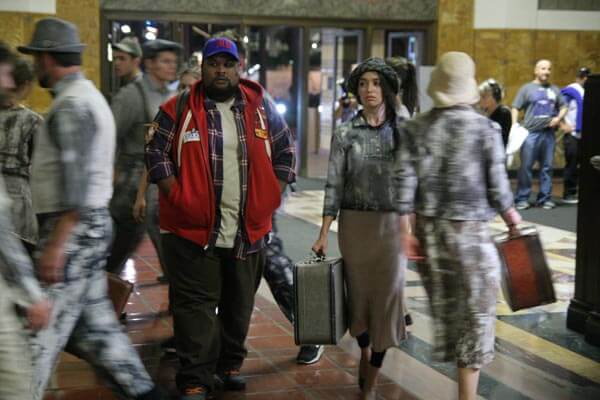
As the overture ended the audiosocial milieu splintered in myriad directions, reconfigured by vibrational social logistics. The audience, drawn by disembodied voices, gravitated towards the Main Waiting Room. Cerrone’s craftsmanship, unmistakable right from the opening motifs, moved with fluid equilibrium between percussive shivers and jolts to expansive clarity and calm. He dedicated the better part of two years to the construction of Invisible Cities, marrying his libretto (derived from Italo Calvino’s 1972 novel) with richly-dense and at times hallucinatory part-writing. The music commanded our attention as the choir, comprised of singers Maria Elena Altany, Sarah Beaty, Stephen Anastasia, and Cale Olson, slowly revealed themselves. The dancers, as they became more focused, would proceed in formation, separate from one another, rejoin, and traverse out of sight again. The Nymphs, exquisitely performed by Delaram Kamareh and Ashley Knight, conveyed a timeless mystique, echoing each other in a detached, indelible vocal ostinato. The effect of all this simultaneous action was dizzying, always balanced by a controlled musicality.
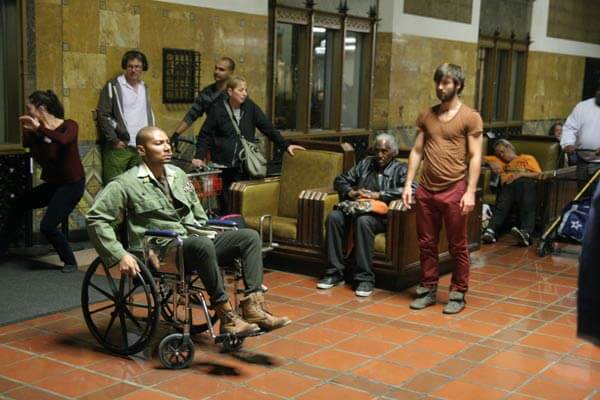
In the libretto, a dialog between Kublai Khan and Marco Polo is centered around descriptions of various cities in a “vast, formless ruin.” Khan seeks Polo’s descriptive illuminations, but they cannot effectively communicate. This rift is given a formalistic treatment in the score, aligned with Calvino’s highly structuralized text. The score is electric at times: passages of bustling percussion/prepared-piano/string-pizzicato lend a prickly punctuation to the frenetic action of choreographer Danielle Agami’s histrionic movements and gestures. Swells and glissandi in the brass cascade downwards in ambiguous hysteria. At other times this chaos is contrasted by sounds of spacious tranquility and earth-bound beauty. Cerrone seeks harmonic stability over problematized (a)tonalities, yet always seems to conjure tension when the text required it.

During the opera, one is driven by perceptual compulsions. The climax, which unfolded in the Historic Ticket Area, brought the collective into its final cathexis, when Kahn and Polo are released from each other, and from the audience. It is a revelatory moment, overwhelming in its totalizing detail. It is this differential ecology of staging and theatrics which casts Invisible Cities as a phenomenal conception. There is vicerality in its interpolated navigability. Its calculated immersion and locativity had a revitalizing effect upon the audience’s awareness. But there was also volatility and transgression (a disruption took place at the performance I attended involving a vagrant woman reciting as if she was a part of the production). Lines such as “I could never imagine a city like this could exist” became double entendres.
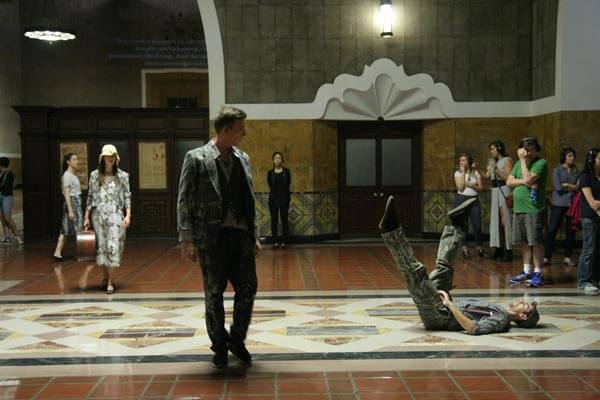
Alas, these are the outcomes in the unpredictable battlefields of art and life. Ashley Faatoalia and Cedric Berry gave resounding performances. The singers, who performed without visible cues from the conductor; E.B. Brooks’ hypersensorial costumes; Nick Tipp’s virtuoso soundboard ‘performance’ (utilizing hundreds of snapshots and constant manipulation of 32 different channels); and Sennheiser’s remarkable technological continuum should not be overlooked. Sharon states that Invisible Cities is not necessarily site-specific, holding a promise that future performances, which will serve to advance the shifting topologies of operatic performance practice, are yet to come. It is interesting to note that Sharon will go on to produce new work in the Badisches Staatstheater Karlsruhe, in close proximity to the Z.K.M., one of world’s most highly regarded new media institutes, which if anything, should serve as a qualitative indication of the conceptual rigor at play in this operatic tour de force.
